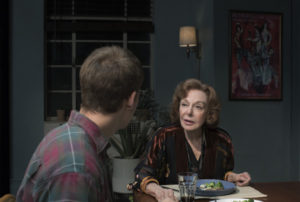 The twenty-first episode of Three on the Aisle, the twice-monthly podcast in which Peter Marks, Elisabeth Vincentelli, and I talk about theater in America, is now available on line for listening or downloading.
The twenty-first episode of Three on the Aisle, the twice-monthly podcast in which Peter Marks, Elisabeth Vincentelli, and I talk about theater in America, is now available on line for listening or downloading.
Here’s an excerpt from American Theatre’s “official” summary of the proceedings:
This week, the critics answer a question from a reader about whether critical standards should be different in reviews of community theatre versus Broadway theatre.
Then they turn the tables on each other! The critics ask each other questions, such as, “Which Shakespeare play would you be happy never to see again?” and “What classic musical or play do you find irredeemably bad?”…
To listen, download the latest episode, read more about it, or subscribe to Three on the Aisle, go here.
In case you missed any previous episodes, you’ll find them all here.

 Broadway has caught up with Kenneth Lonergan, America’s greatest living dramatist, who has now had three of his six full-length plays produced there in the past four seasons, all of them masterly and all satisfyingly well-mounted. “The Waverly Gallery,” first performed in 1999, is an autobiographical memory play narrated by a young man whose grandmother suffers from dementia. It is a harrowingly honest group portrait of the havoc wrought by that disease, not only on those who have it but on those who love them, and this revival, directed with uncommon grace by Lila Neugebauer, is a close-to-ideal enactment of what might just be Mr. Lonergan’s most gripping stage play to date—which is saying something.
Broadway has caught up with Kenneth Lonergan, America’s greatest living dramatist, who has now had three of his six full-length plays produced there in the past four seasons, all of them masterly and all satisfyingly well-mounted. “The Waverly Gallery,” first performed in 1999, is an autobiographical memory play narrated by a young man whose grandmother suffers from dementia. It is a harrowingly honest group portrait of the havoc wrought by that disease, not only on those who have it but on those who love them, and this revival, directed with uncommon grace by Lila Neugebauer, is a close-to-ideal enactment of what might just be Mr. Lonergan’s most gripping stage play to date—which is saying something. “The Ferryman,” Jez Butterworth’s new play, which has transferred to Broadway after a successful London run, is a kind of Irish counterpart of “August: Osage County,” a three-and-a-quarter-hour study of a close-knit rural family that is being pulled apart, in this case by the poisonous effects of political fanaticism. Largely devoid of the self-regarding pretentiousness that made his previous plays unwatchable, it builds to an explosively potent surprise ending whose force is diminished by the fact that it takes Mr. Butterworth most of the garrulous first act to finally get down to dramatic business….
“The Ferryman,” Jez Butterworth’s new play, which has transferred to Broadway after a successful London run, is a kind of Irish counterpart of “August: Osage County,” a three-and-a-quarter-hour study of a close-knit rural family that is being pulled apart, in this case by the poisonous effects of political fanaticism. Largely devoid of the self-regarding pretentiousness that made his previous plays unwatchable, it builds to an explosively potent surprise ending whose force is diminished by the fact that it takes Mr. Butterworth most of the garrulous first act to finally get down to dramatic business…. This question, unlikely as it may sound, came to my mind when Turner Classic Movies recently aired one of the biggest hit movies of 1946. “The Best Years of Our Lives,” in which William Wyler portrayed three vets who had just come home from serving in World War II, won nine Academy Awards and was praised by pretty much everybody who saw it when it first came out. Even the waspish Billy Wilder called it “the best-directed picture I’ve seen in my life.” “The Best Years of Our Lives” declined noticeably in popularity and prestige after 1960, partly because of its length (nearly three hours) and partly because younger critics, among them Pauline Kael and Andrew Sarris, dismissed it as a middlebrow weeper. But the film’s reputation has rebounded in recent years, in part because Mark Harris wrote about it so well in “Five Came Back: A Story of Hollywood and the Second World War” (2014). Today, few months go by without its being screened on cable TV…
This question, unlikely as it may sound, came to my mind when Turner Classic Movies recently aired one of the biggest hit movies of 1946. “The Best Years of Our Lives,” in which William Wyler portrayed three vets who had just come home from serving in World War II, won nine Academy Awards and was praised by pretty much everybody who saw it when it first came out. Even the waspish Billy Wilder called it “the best-directed picture I’ve seen in my life.” “The Best Years of Our Lives” declined noticeably in popularity and prestige after 1960, partly because of its length (nearly three hours) and partly because younger critics, among them Pauline Kael and Andrew Sarris, dismissed it as a middlebrow weeper. But the film’s reputation has rebounded in recent years, in part because Mark Harris wrote about it so well in “Five Came Back: A Story of Hollywood and the Second World War” (2014). Today, few months go by without its being screened on cable TV…
